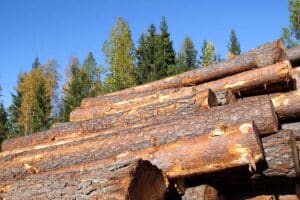Woods provide shade, lumber, mistletoe and toilet paper. They even make oxygen and store carbon.
Name one beach that does anything more than gives you sand itch.
Before Columbus, the 50 states had about one billion wooded acres, about 40 percent of our total land-and-water area. Today, the U.S. Department of Agriculture estimates that forests cover nearly 750 million acres.
America’s woodlands are increasing. Agricultural fields and pastures are returning to trees. Timber users and investors grow their own on plantations dedicated to fast-growing species, like loblolly pine.
Suburban development consumes woodland, but gain in fore st cover has exceeded loss in recent years.
Forests and urban trees together sequestered about 12 percent of the carbon dioxide released by fossil-fuel combustion in the U.S. in 2004, according to the U.S. Environmental Protection Agency.
About half of the Lower 48’s area is currently suited to forests, of which there are about 20 types.
Significant global warming can change the geographic distribution of forest types.
The Midwest will be less suited to forests, and forest types will shift north. A long-term rise in temperature means America will be producing a different mix of tree species. This is not necessarily bad, but it will be different.
U.S. forest quality has declined over the centuries as a result of agriculture, certain logging practices, fire, disease and bugs.
Little virgin timber remains in either public or private hands. Most forested land has been logged several times during the last 200 years.
America’s production of timber products has been essentially flat since the mid-1980s, though consumption—met by imports—increased by 12 percent between 1985 and 2005. We are substituting other products for those coming from freshly cut timber, and we are getting more product out of the timber we use.
U.S. per capita consumption of all timber products (lumber, plywood, veneer, pulp, miscellaneous) fell from 79 cubic feet in 1985 to 71 cubic feet in 2005 even as our population grew from 238.5 million to 296.7 million. (James L. Howard, “U.S. Timber Production, Trade, Consumption, and Price Statistics 1965 to 2005,” USDA, September, 2007.)
If timber production is not growing, why is timberland a sensible investment?
First, less of the total woodland base of 747 million acres is being used to produce timber. Less timberland in production means that timber grows more valuable.
An increasing number of individual owners don’t cut their timber for environmental or aesthetic reasons. Conservation easements that prohibit cutting use tax incentives to withdraw timberland permanently out of production.
A lot of timberland has been recast as higher-and-better use (HBU) property—mainly large lots and second homes. HBU status often backs out timberland from timber production.
As the privately owned timber base contracts, less timber is also being cut from federal lands as a result of opposition to logging’s environmental impacts.
Second, with the exception of plantations, less wood is being harvested per acre in many places than in the not-so-distant past. Hardwood trees with 40-inch diameters were common in my mountain county in the 30s; today, a 24-inch diameter is a dandy. Less timber cut per acre increases the value of the landowner’s stumpage, which is the current commercial value of his timber.
Third, timber prices have trended up over the long term. Stumpage price—what a timber buyer pays a landowner for trees he’s purchased—has increased for most, but not all, species in both federal and private sales.
Federal stumpage prices for all eastern hardwoods rose from $80.90 per thousand board feet in 1985 to $336.50 in 2005, expressed in 1997 dollars. The price of sugar maple increased five-fold. Douglas fir and southern pine rose, but ponderosa pine and western hemlock fell during that period. Federal stumpage prices are generally lower than private-sale prices.
Stumpage prices generally follow a wave cycle that has trended up over time.
Fourth, timberland value is appreciating because of increasing demand for rural second homes and recreational property. The closer the timberland is to a city, the stronger has been its appreciation, particularly when HBU-valued.
In many places, timberland is now too valuable as HBU property to be kept as timber-producing land.
Many investors look to buy timberland at timberland prices, divide and then sell at HBU second-home prices.
Population growth will continue to drive appreciation in timberland values.
The timberland market is also being pushed by demand from large investors–Real Estate Investment Trusts (like Plum Creek, Rayonier and Potlatch), pension funds, endowments, trusts and money managers. Most of the old-line industrial owners—like International Paper and Georgia-Pacific—have sold their timberlands to REITs or Timberland Investment Management Organizations (TIMOs), which manage them on behalf of institutional and individual clients.
It is the combination of timber-sale income and HBU-driven land appreciation that makes timberland profitable.
Fifth, many states offer property-tax breaks for timberland enrolled in their managed-timber programs. The requirements are usually minimal. The reduced valuation can cut annual property tax in half. Property tax is also deductible on a 1040.
Taxes—property and state–discount the value of timberland. New York is a high-tax state; Tennessee is among the lowest inasmuch as it has neither a severance tax on timber sales nor a state income tax on individual landowners. However, timberland is generally cheaper in New York than in Tennessee.
Enrollment in a state’s managed-timber program also helps to establish that a taxpayer is engaged in the business of timberland management and production. A business is afforded more favorable tax treatment than an individual owner who has not organized as a profit-seeking business.
Sixth, timber sold after a year’s ownership is subject to the federal capital-gains rate (now a maximum of 15 percent) rather than the usually higher ordinary-income rate. Federal conservation cost-sharing and reforestation incentives are also available.
Seventh, timber-sale revenue up to the taxpayer’s timber basis is free of federal income tax at the time of the sale. A well-counseled taxpayer can avoid some or all of the tax on both timber-sale gain and appreciation by folding his timberland into the tax-free portion of his estate.
Eighth, a landowner can donate a development-limiting, conservation-promoting easement on his timberland without limiting the use of the tract for timber production. Such conservation easements can bring the taxpayer substantial federal, state and local tax savings.
Ninth, timberland, even small parcels, may qualify in the future for trading on the Chicago Climate Exchange where a landowner would receive income for a certain amount of carbon his trees are storing. Carbon emitters would buy these credits.
This idea is still very much a work in progress. A typical timberland acre might be credited with storing about one-half ton of carbon dioxide annually, currently being purchased for about $3 to $4 per ton.
Anyone buying timberland should have a consulting forester do either a walk-through or a timber cruise before submitting a purchase offer. The forester will provide the buyer with a reasonably accurate estimate of the immediate commercial value of the merchantable timber, along with other valuable information.
Buyers can find local consulting foresters by going to the websites of the Association of Consulting Foresters, Society of American Foresters or the roster of private forestry consultants that individual state forestry departments maintain.
Finally, timberland provides solitude, recreation and family time. Name one stock or bond that does any of that.
This content may not be used or reproduced in any manner whatsoever, in part or in whole, without written permission of LANDTHINK. Use of this content without permission is a violation of federal copyright law. The articles, posts, comments, opinions and information provided by LANDTHINK are for informational and research purposes only and DOES NOT substitute or coincide with the advice of an attorney, accountant, real estate broker or any other licensed real estate professional. LANDTHINK strongly advises visitors and readers to seek their own professional guidance and advice related to buying, investing in or selling real estate.









Great article.
One of the reasons that timberland has been considered as a portfolio stabilizer is that even in a down market timber is growing and changing product classes simply from a biological growth standpoint. Southern pine stands usually grow at an anuual compounded rate in the range of 5 to 7% per year and with this growth product shifting occurs. it is not uncommon for stumpage prices to double when trees grow from pulpwood sized trees into chip & saw and even higher when they reach log or utility pole grade. This is where the timberland owner can really leverage their asset value, if they can hold long term.
I wish I knew of a stock investment that would continue to add value when annual earnings are low along with poor dividend returns and declining per share prices.
An added plus is that you get to see and feel your investment,satisfy your asethetic,wildlife and environmental goals, teach your children a land ethic all while inhaling and smelling the outdoor aroma of pine sap. What else could you ask for?